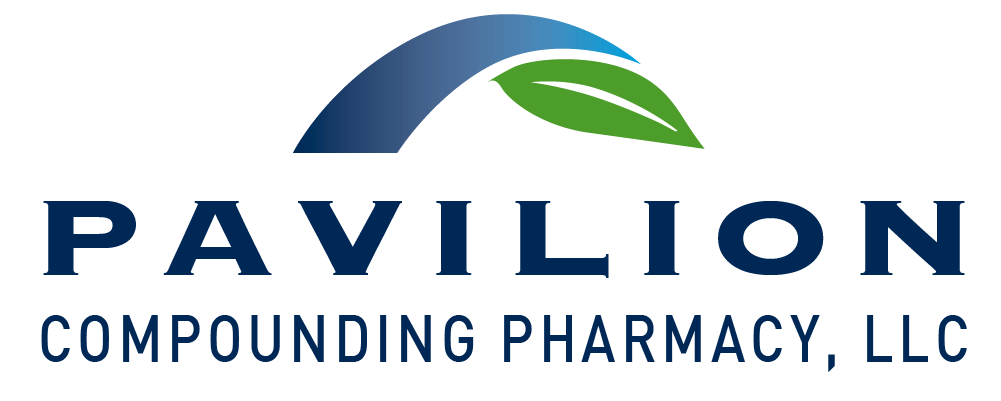Pavilion Compounding Pharmacy is happy to announce our new base, Synapsin, to help support neuronal health!
The support of healthy neurological function is a significant need in the marketplace. Traumatic brain injury (TBI) is a leading cause of injury, death and disability in the U.S. Additionally, as we age, memory impairment is thought to be a consequence of decline in neuronal function and increase in neurodegeneration, with oxidative stress as a major factor in brain aging and memory impairment. More than one million adults in the U.S. are diagnosed annually with a chronic brain disease or disorder, with Alzheimer’s disease being the most prevalent cause of adult-onset brain disorders. Synapsin can also be used for neuronal degradation caused by aging, chronic stress, or executive burnout.
Synapsin is an innovative, patent-pending powder blend of ginsenoside Rg3 and nicotinamide riboside. Synapsin is commonly used in combination with methylcobalamin or hydroxocobalamin in formulations to support neuronal function and cognition.†
Nutrient Support Summary of Synapsin:
- Supports neuronal health†
- Supports NAD+ production in the central and peripheral nervous system, and supports healthy sirtuin expression†
- Supports healthy mitochondrial function†
- Supports the attenuation of microglial activation†
About Ginsenoside Rg3
Rg3 is one of several triterpene saponins (ginsenosides) found in the plant genus Panax, including Panax ginseng (Asian ginseng) and Panax quinquifolius (American ginseng). Laboratory studies report that Rg3 extracted from Panax ginseng supports neuroprotection, helping to support healthy microglial activity and healthy neuronal function.†
About Nicotinamide Riboside
Nicotinamide riboside (NR) is a form of vitamin B3 found in cow’s milk.5 Laboratory studies report administration of nicotinamide riboside supports healthy levels of NAD+ in yeast and cultured human and mammalian cells. NR is reported to be incorporated into the cellular NAD+ pool via the action of nicotinamide riboside kinase (Nrk) pathway or via nicotinamide (Nam) salvage after conversion to Nam by phosphorolysis. Laboratory studies have also reported the supportive and neuroprotective role for NAD+. In laboratory studies, nicotinamide riboside supports neuronal NAD+ synthesis without inhibiting sirtuins, which are important regulators of metabolism and longevity.†
Give Pavilion Compounding Pharmacy a call or e-mail to discuss how we can help. We are happy to make Synapsin available to our patients and providers!
p: (404) 350-5780 f: (404) 350-5640 staff@pavilionrx.com
References
- Hernandez-Ontiveros, D. G., Tajiri, N., Acosta, S., Giunta, B., Tan, J., & Borlongan, C. V. (2013, March 26). Microglia activation as a biomarker for traumatic brain injury. Frontiers in Neurology, 4. https://doi.org/10.3389/fneur.2013.00030
- Joo, S. S., Yoo, Y. M., Ahn, B. W., Nam, S. Y., Kim, Y. B., Hwang, K. W., & Lee, D. I. (2008). Prevention of inflammation-mediated neurotoxicity by Rg3 and its role in microglial activation. Biological and Pharmaceutical Bulletin, 3(7), 1392-1396. http://doi.org/10.1248/bpb.31.1392
- Bao, H. Y., Zhang, J., Yeo, S. J., Myung, C. S., Kim, H. M., Kim, J. M., . . . Kang, J. S. (2005). Memory enhancing and neuroprotective effects of selected ginsenosides. Archives of Pharmacal Research, 28(3), 335-342.
- Mannaa, F., Abdel-Wahhab, M. A., Ahmed, H. H., & Park, M. H. (2006). Protective role of Panax ginseng extract standardized with ginsenoside Rg3 against acrylamide-induced neurotoxicity in rats. Journal of Applied Toxicology, 26(3), 198-206. doi:10.1002/jat.1128
- Bieganowski, P., & Brenner, C. (2004). Discoveries of nicotinamide riboside as a nutrient and conserved NRK genes establish a Preiss-Handler independent route to NAD+ in fungi and humans. Cell, 117(4), 495-502. Retrieved from http://www.cell.com/cell/pdf/S0092-8674(04)00416-7.pdf
- Belenky, P., Bogan, K. L., & Brenner, C. (2007). NAD+ metabolism in health and disease. Trends in Biochemical Sciences, 32(1), 12-19. http://dx.doi.org/10.1016/j.tibs.2006.11.006
- Yang, S. J., Choi, J. M., Kim, L., Park, S. E., Rhee, E. J., Lee, W. Y. . . . Park, C. Y. (2014). Nicotinamide improves glucose metabolism and affects the hepatic NAD-sirtuin pathway in a rodent model of obesity and type 2 diabetes. The Journal of Nutritional Biochemistry, 25(1), 66-72. http://dx.doi.org/10.1016/j.jnutbio.2013.09.004
- Suave, A. A. (2008). NAD+ and vitamin B3: From metabolism to therapies. The Journal of Pharmacology and Experimental Therapeutics, 324(3), 883-893. https://doi.org/10.1124/jpet.107.120758
- Chi, Y., & Suave, A. A. (2013). Nicotinamide riboside, a trace nutrient in foods, is a vitamin B3 with effects on energy metabolism and neuroprotection. Current Opinion in Clinical Nutrition and Metabolic Care, 16(6), 657-661. https://doi.org/10.1097/MCO.0b013e32836510c0
- †Statements made are for educational purposes and have not been evaluated by the U.S. Food and Drug Administration. This product is not intended to diagnose, treat, cure or prevent any disease.
p: (404) 350-5780
f: (404) 350-5640



